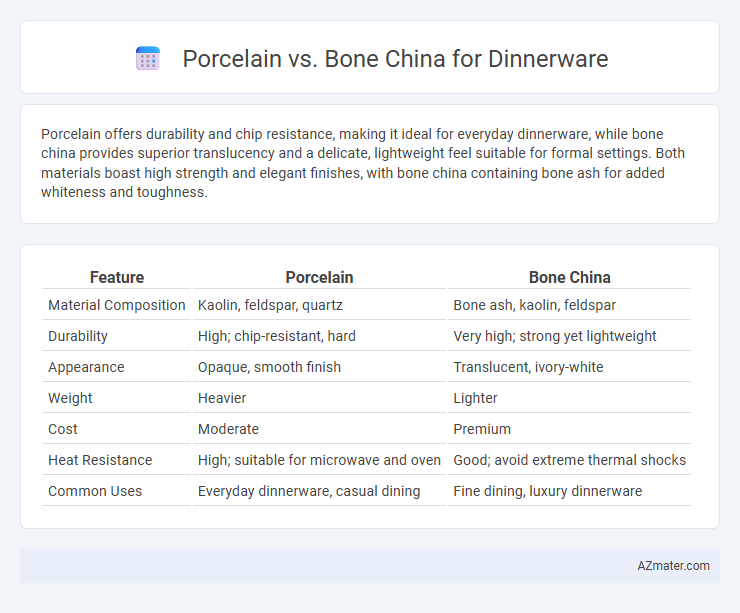Porcelain offers durability and chip resistance, making it ideal for everyday dinnerware, while bone china provides superior translucency and a delicate, lightweight feel suitable for formal settings. Both materials boast high strength and elegant finishes, with bone china containing bone ash for added whiteness and toughness.
Table of Comparison
| Feature | Porcelain | Bone China |
|---|---|---|
| Material Composition | Kaolin, feldspar, quartz | Bone ash, kaolin, feldspar |
| Durability | High; chip-resistant, hard | Very high; strong yet lightweight |
| Appearance | Opaque, smooth finish | Translucent, ivory-white |
| Weight | Heavier | Lighter |
| Cost | Moderate | Premium |
| Heat Resistance | High; suitable for microwave and oven | Good; avoid extreme thermal shocks |
| Common Uses | Everyday dinnerware, casual dining | Fine dining, luxury dinnerware |
Introduction to Porcelain and Bone China
Porcelain and bone china are premium types of ceramic dinnerware distinguished by their composition and firing processes. Porcelain is made from a blend of kaolin clay and feldspar, fired at high temperatures to achieve a hard, translucent finish known for durability and resistance to chipping. Bone china incorporates bone ash into the porcelain mixture, resulting in lighter, thinner, and more delicate tableware with superior whiteness and translucency compared to traditional porcelain.
What is Porcelain Dinnerware?
Porcelain dinnerware is a type of ceramic made from kaolin clay fired at very high temperatures, resulting in a dense, non-porous, and durable material. It offers a smooth, glossy finish and is known for its strength, chip resistance, and elegant translucency that allows light to pass through thin edges. Porcelain is highly valued in dinnerware for its ability to withstand daily use while maintaining a refined appearance.
What is Bone China Dinnerware?
Bone china dinnerware is a type of porcelain made from a mixture of clay, feldspar, and bone ash, which gives it exceptional strength, translucency, and whiteness. It is known for its lightweight yet durable nature, making it resistant to chipping and ideal for everyday use as well as special occasions. The high bone ash content, usually around 30-45%, differentiates bone china from traditional porcelain by enhancing its toughness and creating a delicate, refined appearance.
Key Differences Between Porcelain and Bone China
Porcelain dinnerware is made from a mixture of kaolin, feldspar, and quartz, offering high durability and a translucent quality, whereas bone china incorporates bone ash for added whiteness and strength while being lighter and more chip-resistant. Bone china boasts a warmer, ivory tone and a smoother, more vitreous finish compared to the cooler, slightly opaque appearance of porcelain. Porcelain tends to be thicker and heavier, making bone china preferred for fine dining settings due to its refined elegance and resilience.
Durability and Strength Comparison
Porcelain and bone china differ notably in durability and strength, with porcelain being denser and more resistant to chipping due to its higher firing temperature and composition primarily of kaolin clay. Bone china contains bone ash, which imparts exceptional whiteness and translucency but makes it slightly more fragile compared to porcelain. For everyday dinnerware, porcelain's robustness and resistance to thermal shock make it a preferred choice, whereas bone china suits formal occasions requiring a delicate yet elegant appearance.
Appearance and Design Variations
Porcelain dinnerware is known for its smooth, translucent surface and classic white color, offering a sleek appearance that pairs well with modern and minimalist designs. Bone china, infused with bone ash, provides a warmer, slightly ivory hue and increased translucency, allowing for delicate patterns and intricate designs that emphasize elegance and sophistication. Both materials support a wide range of decorative finishes, but bone china's finer composition often results in more refined, lightweight pieces ideal for upscale table settings.
Weight, Feel, and Everyday Usability
Porcelain dinnerware is generally heavier and denser than bone china, offering a sturdier feel that can better withstand daily use without chipping easily. Bone china, made with bone ash, is lighter, more translucent, and offers a delicate, refined feel, making it ideal for elegant dining but more prone to chipping under frequent use. For everyday usability, porcelain's durable and robust nature suits high-traffic kitchens, while bone china demands more careful handling despite its aesthetic appeal.
Cost and Value Considerations
Porcelain dinnerware typically offers a more affordable option compared to bone china, making it a practical choice for everyday use without sacrificing elegant aesthetics. Bone china, known for its superior strength and translucency due to higher bone ash content, commands a higher price but delivers exceptional durability and a luxurious feel. Evaluating the balance between initial cost and long-term value, bone china often justifies its investment for formal dining, while porcelain remains cost-effective for casual settings.
Suitability for Formal and Casual Dining
Bone china offers exceptional elegance and translucency, making it highly suitable for formal dining occasions where refined presentation is desired. Porcelain is highly durable and versatile, making it ideal for casual everyday use while still maintaining a sophisticated appearance. Both materials resist chipping and staining, but bone china's delicate finish enhances upscale table settings, whereas porcelain balances practicality with aesthetic appeal for diverse dining environments.
Care, Maintenance, and Longevity
Porcelain dinnerware requires gentle hand washing with mild detergent to prevent surface scratches and maintain its glossy finish, while bone china offers greater durability and is often dishwasher-safe, making care easier and extending its lifespan. Both materials benefit from avoiding sudden temperature changes to prevent cracking, but bone china's higher strength and chip resistance contribute to longer-lasting use. Proper storage in padded compartments further preserves the delicate edges and maintains the dinnerware's pristine appearance over time.

Infographic: Porcelain vs Bone china for Dinnerware
 azmater.com
azmater.com